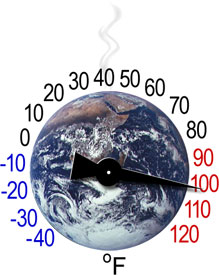
A University of California Museum of Paleontology short course
Global climate change and its influence on evolution
There are growing concerns that we are experiencing global warming at a level that will have major consequences. But both global warming and global cooling have occurred in the past, so how is this different? Meet and chat with experts to learn about past global climate changes and how they have influenced evolution, even our own, and what the implications might be for the future.
Saturday, February 9, 2008
in Room 2050 Valley Life Sciences Building, UC Berkeley
Agenda
Parking information9:15-10:15
Climate and the evolution of Earth's terrestrial biota
Bruce H. Tiffney, Professor of Paleobiology and Dean, College of Creative Studies, University of California Santa Barbara
Terrestrial life and Earth have evolved in a reciprocal dance over the past 450 million years, often with climatic change calling the tune. This change is hypothesized to have been driven by causes that are as apparently unrelated as plate tectonics, oceanic circulation, plant evolution, extraterrestrial impacts and (most recently) the actions of some hairless apes, and at rates ranging from hundreds to millions of years. Commencing with the effects of plants invading land at a time of great tectonic activity (thus cooling the Earth and driving atmospheric oxygen to far greater levels than at present) we will touch on some high points of climate change — the Permo-Triassic extinction (great warming) — the Paleocene Thermal Maximum (sudden warming) and succeeding Early Eocene Thermal Maximum — The gradual Oligo-Miocene cooling — and if time permits the gradual coolings and sudden warmings of the Pleistocene. Recommended resources
10:25-11:25
Did global climate change influence human evolution?
Tim White, Professor of Integrative Biology, and Director, Human Evolution Research Center, UC Berkeley
It has been claimed that many of the major events and trends in human evolution are consequences of global climate change. With a six-million-year paleobiological record of human origins and evolution, a rich associated behavioral record for the last half of that, and an increasingly detailed set of proxies for global climatic change, we are now in a position to examine these claims. Recommended resources
11:35-12:35
The green evolution: how climate has shaped plants and plant communities through time — and vice versa
Caroline Strömberg, Assistant Professor of Biology, University of Washington, and Curator of Paleobotany, Burke Museum of Natural History and Culture, Seattle
The influence of climate on the distribution of today's plants is well-known and has led to the assumption that climate was a major driver in both land plant evolution and global vegetation change in the past. Recent improvements in the quality and quantity of the plant fossil record and in our tools for inferring plant function and climate, respectively, allow a more detailed understanding of the close link between climate and land plant evolution. Emphasizing the last 65 million years of Earth history, Strömberg will discuss what the fossil record can tell us about evolutionary and ecological responses of plants to climate change occurring over both long (106 years) and short (104 years) time scales. Particular emphasis will be given to examples relating to the formation of modern biomes, such as the spread of grassland ecosystems. Recommended resources
12:35-1:30
1:30-2:30
Break for lunch (on your own)
Effects of recent climate change on California birds and mammals — and improving projections for the future
Craig Moritz, Professor of Integrative Biology and Director, Museum of Vertebrate Zoology, UC Berkeley
Between 1904 and 1940, the founding Director of the Museum of Vertebrate Zoology, Joseph Grinnell, and his colleagues documented and collected mammals, birds, amphibians and reptiles from more than 700 locations, providing a remarkable snapshot of early 20th century biodiversity in California. Today, 100 years later, these same sites are being revisited in order to document changes in bird and small mammal distributions over the past century. This effort, known as the Grinnell Project, also seeks to improve methods for predicting responses to future climate and land-cover change. Moritz will review the objectives and findings of this remarkable project. Recommended resources
2:40-3:50
Rapid evolution caused by human-induced environmental changes
Steve Palumbi, Professor of Biological Sciences, Stanford University and Hopkins Marine Station
Human change of the biosphere results in strong selection pressure because ecosystem properties have been so seriously altered. For species with big population sizes and short generation times, rapid evolution is often the result such as in many microbial disease organisms, small insects, common fisheries species and annual plants. Species with small populations or long generation times tend not to respond to human change evolutionarily but instead exhibit rapid declines in population numbers: such species are most likely to be listed as endangered or extinct. Human action can also affect speciation rates. The most rapid speciation occurs when disruptive selection occurs across a landscape where movement is curtailed. When humans create a fragmented landscape across an environmental mosaic, rapid divergence and reproductive isolation can result. Rapid evolution due to human environmental change is not just an intellectual curiosity. It generates huge costs in medical care and in agricultural losses. It may also increase the rate of evolution of highly virulent diseases or particularly noxious weeds. Recommended resources
3:50-4:00
Closing comments
About the speakers
Tim White is Professor of Integrative Biology and Director of the Human Evolution Research Center (HERC), UC Berkeley. He has studied most of the hominid record, working on evolving morphologies, contexts, and behaviors of early hominids as well as the other taxa they are embedded among. He is a co-leader of the Middle Awash research project in Ethiopia, one of the most successful human paleobiological investigations.
This short course is co-sponsored by the California Science Teachers Association, the California Academy of Sciences, the Oakland Museum of California, and the UC Berkeley Natural History Museums.
Questions? Contact